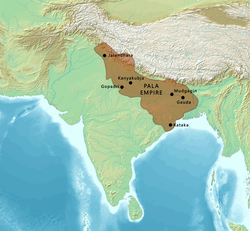Pala Empire
The Pāla Empire (r. 750-1161 CE)[1][2] was an imperial power during the post-classical period in the Indian subcontinent,[3] which originated in the region of Bengal. It is named after its ruling dynasty, whose rulers bore names ending with the suffix Pāla ("protector" in Prakrit). The empire was founded by Gopala I in late eighth century AD.[1] The Pala stronghold was located in Bengal and eastern Bihar, which included the major cities of Gauḍa, Vikramapura, Pāṭaliputra, Monghyr, Somapura, Ramavati (Varendra), Tāmralipta and Jaggadala.[4]
The Pala rulers were patrons of Buddhism. They built grand temples and monasteries, including the Somapura Mahavihara and Odantapuri, and patronised the great universities of Nalanda and Vikramashila. The empire enjoyed relations with the Srivijaya Empire, the Tibetan Empire and the Arab Abbasid Caliphate. The Pala legacy is still reflected in Tibetan Buddhism.[5]
- Further reading
 Pala Empire, Wikipedia
Pala Empire, Wikipedia
Notes
- ↑ 1.0 1.1 R. C. Majumdar (1977). Ancient India. Motilal Banarsidass. pp. 268–. ISBN 978-81-208-0436-4.
- ↑ Sengupta 2011, pp. 39–49.
- ↑ Sailendra Nath Sen (1999). Ancient Indian History and Civilization. New Age International. pp. 280–. ISBN 978-81-224-1198-0.
- ↑ Satish Kumar, Satish; Jha, Tushar (2017). "Contours of the Political Legitimation Strategy of the Rulers of Pala Dynasty in Bengal- Bihar (Ce 730 to Ce 1165)". Proceedings of the Indian History Congress. 78: 49–58. JSTOR 26906068.
- ↑ Dahiya, Poonam Dalal (2017-09-15). ANCIENT AND MEDIEVAL INDIA EBOOK. McGraw-Hill Education. pp. 411–414. ISBN 978-93-5260-673-3.
